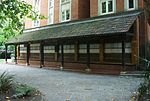Little Britain, London

Little Britain is a street in the City of London running from St. Martin's Le Grand in the east to West Smithfield in the west. It is situated in the Aldersgate and Farringdon Within wards. Postman's Park is also bounded by Little Britain. Historically, Little Britain referred to a small district in the City just north of London Wall, including this street. Washington Irving described this district in The Sketch Book of Geoffrey Crayon, Gent., published in 1820. The opening paragraph reads: IN the centre of the great City of London lies a small neighborhood, consisting of a cluster of narrow streets and courts, of very venerable and debilitated houses, which goes by the name of LITTLE BRITAIN. Christ Church School and St Bartholomew's Hospital bound it on the west; Smithfield and Long Lane on the north; Aldersgate Street, like an arm of the sea, divides it from the eastern part of the city; whilst the yawning gulf of Bull-and-Mouth Street separates it from Butcher Lane and the regions of Newgate. Over this little territory, thus bounded and designated, the great dome of St. Paul's, swelling above the intervening houses of Paternoster Row, Amen Corner, and Ave-Maria Lane, looks down with an air of motherly protection. Booksellers dominated the street from the mid-16th century, followed by goldsmiths and clothing trades from the mid-18th to the 20th centuries.
Excerpt from the Wikipedia article Little Britain, London (License: CC BY-SA 3.0, Authors, Images).Little Britain, London
Little Britain, City of London
Geographical coordinates (GPS) Address Nearby Places Show on map
Geographical coordinates (GPS)
| Latitude | Longitude |
|---|---|
| N 51.517 ° | E -0.0978 ° |
Address
Memorial to Heroic Self Sacrifice
Little Britain
EC1A 4EU City of London
England, United Kingdom
Open on Google Maps










